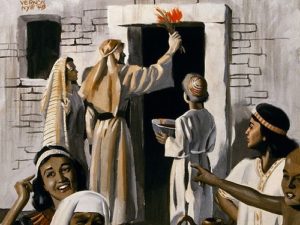 January 1 as New Year’s Day was first celebrated in 46 B.C. when the Julian calendar took effect. The traditional Roman calendar, first established in the 7th century B.C. was based on the lunar cycle. Various politicians would add days to extend their own political terms and thus it was frequently corrupted. Julius Caesar, the new Roman dictator, named the new calendar after himself. Instead of the lunar cycle, he followed the solar cycle. So what can we learn about the new year that could enlighten us today?
January 1 as New Year’s Day was first celebrated in 46 B.C. when the Julian calendar took effect. The traditional Roman calendar, first established in the 7th century B.C. was based on the lunar cycle. Various politicians would add days to extend their own political terms and thus it was frequently corrupted. Julius Caesar, the new Roman dictator, named the new calendar after himself. Instead of the lunar cycle, he followed the solar cycle. So what can we learn about the new year that could enlighten us today?
 In Exodus 12:1-2 the Scripture states, “Now the Lord spoke unto Moses and Aaron in the land of Egypt, saying, ‘this month shall be your beginning of months; it shall be the first month of the year to you.’” This set the beginning of the year among God’s people to be 1 Nisan at the time of the Passover. Not only was this day the beginning of the nation of the Hebrew people, but it also signified their redemption and deliverance from slavery in Egypt. On a yearly basis, 1 Nisan was set at the first new moon in spring, when the waxing crescent of the moon was first sighted, usually in March. Since the fourth century the Jewish calendar designates the new year in the fall with Rash Hashanah.
In Exodus 12:1-2 the Scripture states, “Now the Lord spoke unto Moses and Aaron in the land of Egypt, saying, ‘this month shall be your beginning of months; it shall be the first month of the year to you.’” This set the beginning of the year among God’s people to be 1 Nisan at the time of the Passover. Not only was this day the beginning of the nation of the Hebrew people, but it also signified their redemption and deliverance from slavery in Egypt. On a yearly basis, 1 Nisan was set at the first new moon in spring, when the waxing crescent of the moon was first sighted, usually in March. Since the fourth century the Jewish calendar designates the new year in the fall with Rash Hashanah.
The origin of the reckoning of time can be traced to Creation. Genesis 1:14 states, “Then God said; ‘let there be lights in the firmament of the heavens to divide the day from the night; and let them be for signs and seasons, and for days and  years.’” The reckoning of time among the ancients was by the phases of the moon in relation to the seasons. The reckoning of days initially came from the Biblical phrase “and the evening and the morning were the first day” (Genesis 1:5). Thus, a day began in the evening (eventually about 6 PM) and ended the next evening at 6 PM – evening and morning in that order. This kind of time keeping was preserved among the ancient Israelites regardless of whether they were free or ruled by some monarch with a different kind of reckoning. Also, the Jews counted the years from the creation of Adam, and thus anno mundi – or “in the year of the world” was utilized, such as this gravestone outside Thessalonica.
years.’” The reckoning of time among the ancients was by the phases of the moon in relation to the seasons. The reckoning of days initially came from the Biblical phrase “and the evening and the morning were the first day” (Genesis 1:5). Thus, a day began in the evening (eventually about 6 PM) and ended the next evening at 6 PM – evening and morning in that order. This kind of time keeping was preserved among the ancient Israelites regardless of whether they were free or ruled by some monarch with a different kind of reckoning. Also, the Jews counted the years from the creation of Adam, and thus anno mundi – or “in the year of the world” was utilized, such as this gravestone outside Thessalonica.
Prior to the coming of Christ, ancient monarchs marked years according to their own rule. When Julius Caesar changed the Roman calendar in 45 B.C., March had been the month of the new year with a ten month calendar. September through December, after all, means 7th through the 10th month of the year! The new Julian year was calculated to be 365 and one quarter days, with Caesar adding 67 days (two new months) but also adding one day in February every four years. Caesar changed the month of Quintilis (5th month from March) to Julius, or July. Later, after his assassination, the month of Sextilis (6th) was renamed Augustus (August) for his successor. In time, scholars realized that the actual year was 11 minutes longer than he had calculated, requiring further corrections by 1000 A.D. Thus, by 1582 Pope Gregory XIII wanted another reform of the calendar that still bears his name today.
 Though the Gregorian calendar (and January 1 as New Year’s Day) had been adopted by most European Nations since 1582, the Pilgrims arrived on the shores of New England with the Julian calendar but using March 25, or the Feast of Annunciation, as the new year. Protestant England resisted the system of dating that Catholic Europe had adopted. The Feast of Annunciation was designated in the late 600’s (7th century) as the date of the incarnation when the angel appeared to Mary. This was done in conjunction with the earlier designation of December 25 as the time of Christ’s birth. The Pilgrims, like others of the Reformation, utilized the month of March as the New Year, though they would not have celebrated Annunciation. Reformed theology designated only the Lord’s Day once a week as a true holy day. Both Annunciation and Passover, however, indicated the start of a new year in March and coincided with the ancient Hebrew calendar.
Though the Gregorian calendar (and January 1 as New Year’s Day) had been adopted by most European Nations since 1582, the Pilgrims arrived on the shores of New England with the Julian calendar but using March 25, or the Feast of Annunciation, as the new year. Protestant England resisted the system of dating that Catholic Europe had adopted. The Feast of Annunciation was designated in the late 600’s (7th century) as the date of the incarnation when the angel appeared to Mary. This was done in conjunction with the earlier designation of December 25 as the time of Christ’s birth. The Pilgrims, like others of the Reformation, utilized the month of March as the New Year, though they would not have celebrated Annunciation. Reformed theology designated only the Lord’s Day once a week as a true holy day. Both Annunciation and Passover, however, indicated the start of a new year in March and coincided with the ancient Hebrew calendar.
 In the year 1752 England and her Colonies in America adopted the Gregorian calendar. Eleven days were initially added to former dates to “correct them.” December 11, the day the Pilgrims stepped on Plymouth Rock, for instance, one of America’s first holidays (Forefathers Day), was first celebrated by the Old Colony Club on December 22nd. When it was later realized that only 10 days were needed to be added, the Pilgrim Society, formed in 1820, celebrated it December 21st. Both days are celebrated today in Plymouth. However, confusion between the “old style” (Julian dates) and “new style” (Gregorian dates) occur when both are listed.
In the year 1752 England and her Colonies in America adopted the Gregorian calendar. Eleven days were initially added to former dates to “correct them.” December 11, the day the Pilgrims stepped on Plymouth Rock, for instance, one of America’s first holidays (Forefathers Day), was first celebrated by the Old Colony Club on December 22nd. When it was later realized that only 10 days were needed to be added, the Pilgrim Society, formed in 1820, celebrated it December 21st. Both days are celebrated today in Plymouth. However, confusion between the “old style” (Julian dates) and “new style” (Gregorian dates) occur when both are listed.
 So where did B.C. and A.D. come from? Prior to these designations, the Council of Nicaea, in 325 A.D., designated Easter to be the Sunday following the full moon after the Spring Equinox. Utilizing the tables of such calculations, Dionysius Exiguus, a Monk of Scythia Minor introduced the A.D. system, having calculated the years since the birth of Christ. B.C. meant “before Christ” and A.D. meant “in the year of the reign of Christ.” The entire system was based on placing Christ at the center of time and the anchor to the calendar. Though scholars later believed that Christ was born in 3 or 4 B.C., the point of dating all of time with Christ was theological for it focused people on the fact that history prior to Christ’s birth awaited His revelation and history following His coming has progressively revealed the reign of Christ and advance of His Kingdom. Today, the terms BCE (before common era) and CE (common era) are replacing BC and AD. Though these terms take us away from the focus on Christ, the dates and years are the same.
So where did B.C. and A.D. come from? Prior to these designations, the Council of Nicaea, in 325 A.D., designated Easter to be the Sunday following the full moon after the Spring Equinox. Utilizing the tables of such calculations, Dionysius Exiguus, a Monk of Scythia Minor introduced the A.D. system, having calculated the years since the birth of Christ. B.C. meant “before Christ” and A.D. meant “in the year of the reign of Christ.” The entire system was based on placing Christ at the center of time and the anchor to the calendar. Though scholars later believed that Christ was born in 3 or 4 B.C., the point of dating all of time with Christ was theological for it focused people on the fact that history prior to Christ’s birth awaited His revelation and history following His coming has progressively revealed the reign of Christ and advance of His Kingdom. Today, the terms BCE (before common era) and CE (common era) are replacing BC and AD. Though these terms take us away from the focus on Christ, the dates and years are the same.
So what lessons can be learned as we all anticipate the arrival of 2018 on January 1st?
- First, the most important point is that the new year, looking forward with great anticipation for deliverance and greater freedom is rooted in Biblical meaning in the Scriptures;
- A calendar serves us best when its anchor (or focus) is God (such as creation for the designation of time) and Christ (B.C. / A.D.), rather than man.
- Finally, a new year should give us a providential perspective on both the past and the future as we see events in a broader perspective. This allows us to see both negative and positive events in a way that can be more objective, seeing a measure of God’s purposes in view.







